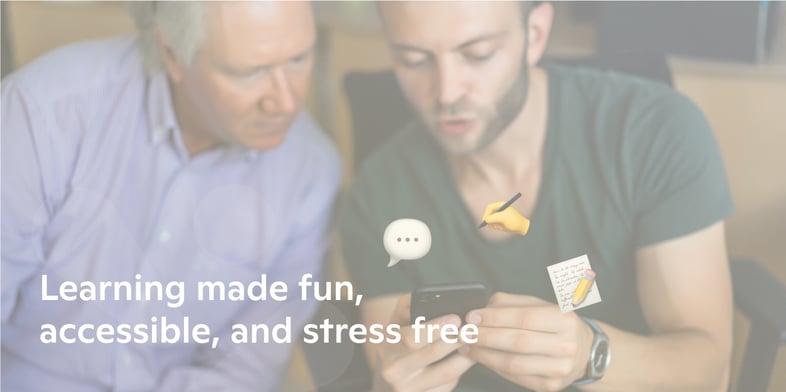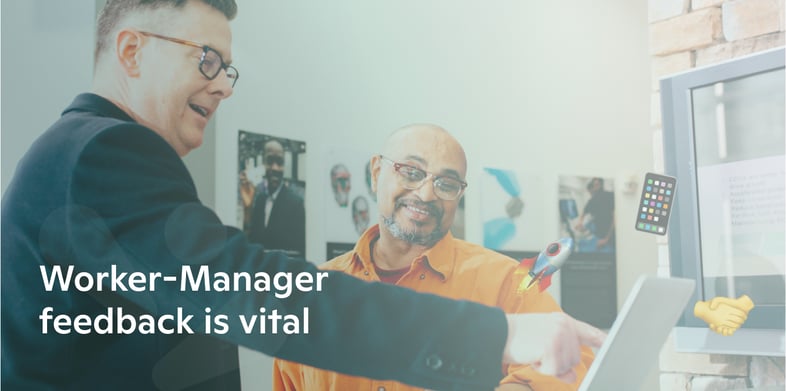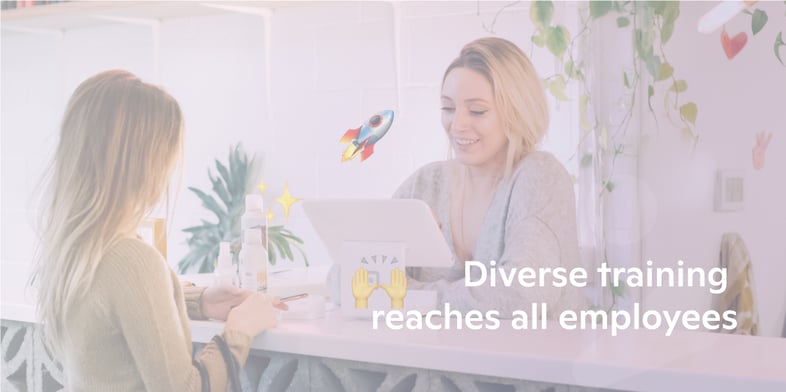The Productivity Problem
why companies digitalize deskless training
What’s the concern HR, corporate, and store managers share? Simple – they’re all agonizing over productivity.
This pain is universal, as most companies leave productivity on the table. Look at the data; deskless workforce engagement stands at a mere 18%. That's the high end - and HR departments are struggling to improve this figure.
We’ve all been there - Your team hires a great candidate who seems to be what your workplace is missing. Yet, despite being brilliant, popular, and capable, they don’t meet their targets. They struggle to learn best practices and are confused as to where they can find help.
But for many frontline workers, experience doesn’t guarantee survival. A change in routine, or tweaked processes, can leave even old hands feeling like new hires.
The problem here is poor guidance.(1) A frontline worker’s ability to access training determines their resilience and confidence. We’ve all heard the expression ‘back to square one’. In a workplace with a poor approach to training, square one is whenever change occurs, leading to low employee retention rates.(2)
Some companies tolerate high churn. They believe improving training would be expensive or get in the way of the workday. They’re wrong.
Outdated training isn't only confusing, it's devastating for workplace culture. Hiring constant replacements means institutional knowledge never has an opportunity to build. The best workers will realize this and quit while they’re behind.

Take this fact to heart: well-trained employees produce two and a half times more income for the company than poorly trained employees – and that’s just the average.(3)
We’ve broken down the benefits of digital training that companies can reap right now without radical procedural change.
Perk One: Training Programs as Engagement Programs
How to turn frontliners into focused participants
Faced with a task that seems dull, and a task that makes you smile, let’s be honest, you’d take the second option. We all would.

There’s a reason why we use games to relax, reset, or procrastinate. Games reward the players by constantly reminding them of their progress. The fun comes from being rewarded – from attaching the skills you’ve learnt to tokens of success.
The future of workplace learning is ‘Gamification’ – for a good reason. 90% of surveyed workers report that they find skill development easier when it’s made into a game.(4) Since most people are playful, the ability to play while you learn harnesses an employee’s sense of engagement.
Furthermore, a score-based digital training platform taps into an employee’s need to compete. Traditional learning documents and video demonstrations are far more enticing when combined with a point-scoring system. To earn points, the employee must showcase how much they learnt passing a quiz system built into the training program.
This gifts employees with rapid feedback – without their supervisor needing to be present. In effect, employees supervise their own learning – checking and scoring themselves in a repeatable, low-stakes format, giving employees a sense of ownership over their learning outside of seminars. Equally, employees will want to test themselves against their peers, scoring their learning outcomes against their colleagues.
This method is so successful at driving engagement, keen employees will access gamified courses at their own pace – between projects, during low-intensity shifts, or during free time. The result is a learning experience that feels fun, accessible, and stress free.
Even better, digital training aligns an employee’s goals with their supervisor, colleagues, and company at large. As engaged employees complete modules, management measures how employees respond to different courses and modules, allowing for optimization down the road.

From an employer’s perspective, it’s a chance to build desirable workflows into their employees’ approach to problem-solving. From familiarizing staff with standards, through to coaching behavior, gamified training fleshes out an employee’s mental toolkit to match policy – with obvious benefits to workplace safety, customer experience, and quality assurance.
Perk two: Training for Fulfilment
Nurture employee value with adaptive training
Self-esteem is retention. Your workforce can’t have enough of it.
Believing your professional value is growing over time is the backbone of any fulfilling career. The opposite is also true; it’s human nature to be unproductive if you know you’re not growing professionally.

In any given year, employees undergo tremendous skill, character, or aspirational change – with, or without the input of their employer. That’s part of growth – and it’s inevitable. One side effect is that employees never have the same perspective of their employer on day one, than at day one hundred. In short, the difference between a job and a career, is if the employee feels their job is complimenting their professional growth.
Bite-sized training with rapid feedback is proven to be most effective form of workplace learning. Many small steps analyzed often are an important part of sensemaking; the process people use to understand complex situations like an evolving work environment.(5) Digital learning environments are well-suited to analyzing progress, as on-screen tabulation of learning outcomes boosts attainment by making personal development obvious.
An often-overlooked perk of workplace training courses is that they not only nurture value for the company, but also the wellbeing of employees. When people learn at work, they realize that their professional capabilities are expanding, restoring confidence in themselves and in their career trajectory. Trained workers are fulfilled workers, willing to stay with the company for the long haul.
Digital learning platforms support worker fulfillment by giving management the power to make quick changes to course structures, modules, and units; without needing to reprint and republish guidance. This means that training can be updated responsively during process changes, ensuring staff know that what they learn is relevant to what they’re paid to do.
Perk three: Streamline Administration and Management
Detangle feedback between workers and supervisors
According to Gallup, understanding between supervisor and worker is vital for success. How an employee connects with their manager determines up to 70% of engagement with their job.(6) That’s a make-or-break percentage. Taken company-wide, It’s the difference between growth and hemorrhaging money.

Unlike desk workers, who use business software for training, frontliner learning processes can be horribly antiquated. Store managers, for example, frequently lack standardized workflows for giving feedback. Deskless correspondence is a dizzying mix of emails, printed guidebooks, text messages, and even unsecure social media messages – all stored in different locations.
This mishmash of information channels harms training by forcing deskless employees to track down many sources of guidance. Messy systems discourage managers, who are forced to write feedback across a range of platforms. This is time-consuming and makes comparing outcomes between employees arbitrary.
A digital learning portal centralizes all feedback channels in one place. For managers, this gives them an overview of their team’s performance. Combined with instant messaging functions for quick communication between team members, hours of marking can be distilled into a matter of minutes.
This enables human feedback from supervisors to be organic – reacting to trainee development on demand. That efficiency doesn’t end at the store – but helps the entire organization. With all learning outcomes digitalized, the training results of local workplaces can be charted into an automated performance report for upper management. HR departments reap the rewards with precise status updates from team leaders and store managers, for minimal time invested.
Perk four: Benchmark learning performance
Learn trainees' needs and how to respond
The ideal deskless worker is a human Swiss army knife – as confident with customers as in the stockroom. In consequence, productive workers are flexible; armed with a wide set of skills. A training program needs to be diverse to match, containing a range of documentation and media.

For example, soft skills such as customer relations are best taught through video, while procedural information or an employee handbook is well-suited to guidebooks. Remember, different people prefer different forms of learning – some enjoy reading, while others engage with visuals. A mixed-media training program will satisfy all employees, improving attainment and memorization.
The best digital learning platforms presents guidance as a sequence. This allows managers to set the order through which documentation can be accessed by trainees. After all, there’s no point in learning the details before you learn the basics. By breaking guidance into a step-by-step, bite-sized program, bosses can track a team’s engagement with learning over time, while standardizing the curriculum for all learners, preventing gaps in expertise. This is called microlearning – and it’s great at stopping fatigue.
By benchmarking which guidance, modules, and media your staff responds to, management can use the data to iteratively improve courses to better fit the work force. As your organization grows and new trainees provide new data, you can tailor a data-driven learning program unique to your use-case, radically improving the malleable skill development of future trainees.(7)
Perk five: Future-proof the workforce
Reap the benefits, companywide
Here are the facts: a frontline company offering consistent training for their employees’ averages earnings 24% higher than companies which do not offer the same opportunities.(3)

That estimate is likely lower than the real value. It doesn’t factor the hidden benefits of digitalized training, including less paperwork for store supervisors, and informed decision-making for upper management, courtesy of digitalized reports on training outcomes. In short, compared to the 19 billion dollars retailers lose every year to staff turnover, digitalized training pays for itself.(3)
Sources
Shsmd.org “Engaging the Deskless Workforce – a white paper for communications professionals” https://www.shsmd.org/system/files/media/file/2020/04/Whitepaper%20-%20Engaging%20a%20Deskless%20Workforce%20%20-%20Lexi%20McCausland.pdf (1)
US Bureau of Labor and Standards – “JOB OPENINGS AND LABOR TURNOVER – NOVEMBER 2022” https://www.bls.gov/news.release/pdf/jolts.pdf (2)
1997 American Society for Training and Development study, “Buisnesstrainingexperts.com” https://businesstrainingexperts.com/knowledge-center/training-roi/profiting-from-learning/ (3)
Zippia. "25 Gamification Statistics [2022]: Facts + Trends You Need to Know" Zippia.com. Sep. 28, 2022, https://www.zippia.com/advice/gamification-statistics/ (4)
Oxford Review, “Encylopedia of terms”, https://oxford-review.com/oxford-review-encyclopaedia-terms/sensemaking/ (5)
Gallup, “2022 workplace Report” https://www.gallup.com/workplace/285674/improve-employee-engagement-workplace.aspx (6)
María F. Prada, Graciana Rucci and Sergio Urzua December 2019 ”Soft Skills Training and Productivity: Evidence from an intervention in retail” http://econweb.umd.edu/~urzua/VersionILR_mfp.pdf (7)
Contains discreet data and assertions sourced from Relesys


-Jan-17-2023-01-17-53-1140-PM.jpeg)


